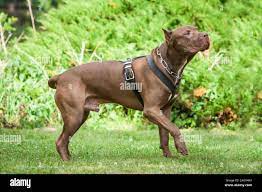Welcome pitbull tail to the wonderful world of Pitbull breeds, where these loyal and affectionate dogs steal our hearts with their playful antics and loving nature. One distinctive feature that sets them apart is their tails, which come in various shapes and sizes. In this blog post, we will dive into the key points about Pitbull tails – from understanding their different types to debunking common myths and providing tips for proper care. So, grab a cup of coffee, sit back, and let’s explore everything you need to know about Pitbull tails!
Understanding Pitbull Tail Types and Characteristics
Pitbull breeds are known for their diverse tail types and characteristics, each adding to their unique charm. Some Pitbulls have a naturally long, curved tail that wags happily when they’re excited or content. Others may have a shorter, straighter tail giving them a more compact appearance.
The shape and length of a Pitbull’s tail can vary depending on their lineage and genetics. It’s essential to understand these differences to better appreciate the individuality of each dog. Tail wagging is not only an expression of joy but also serves as a form of communication for Pitbulls.
By observing your Pitbull’s tail movements, you can gain insight into their emotions and mood. Understanding your dog’s tail type can help strengthen the bond between you both and ensure proper care tailored to their specific needs. Embrace the diversity in Pitbull tails as it adds character and personality to these loving companions!
The Importance of Proper Tail Care for Pitbulls
Proper tail care is an essential aspect of responsible pet ownership when it comes to Pitbulls. Regularly checking your Pitbull’s tail for any signs of injury or infection can help prevent potential health issues down the line. Ensuring that the tail is clean and dry can also contribute to maintaining good overall hygiene for your furry friend.
Trimming your Pitbull’s nails regularly can help prevent accidental injuries caused by wagging their tail too vigorously, especially in smaller spaces. Additionally, providing your Pitbull with a comfortable and safe environment to move around freely without obstacles can minimize the risk of them injuring their tail.
If you notice any changes in your Pitbull’s tail behavior, such as excessive licking or biting, it may be a sign of discomfort or pain that requires prompt attention from a veterinarian. Remember, caring for your Pitbull’s tail goes beyond just aesthetics; it plays a crucial role in their overall well-being and happiness.
Common Myths and Misconceptions about Pitbull Tails
There are many myths and misconceptions surrounding pitbull tails that can lead to misunderstandings about these loyal and loving dogs. One common myth is that all pitbulls have docked tails, but in reality, this practice is not as common as some may believe. Another misconception is that a wagging tail always means a happy dog; while tail wagging can indicate happiness, it can also signal nervousness or caution depending on the situation.
Some people mistakenly think that longer tails make pitbulls more aggressive, which is simply not true. The length of a dog’s tail has no bearing on their temperament or behavior. Additionally, there’s a myth that cropped tails are necessary for pitbulls to be considered purebred, but this is false – natural tails are just as valid.
It’s important to educate ourselves and others about these myths so we can better understand and appreciate the diversity of pitbull breeds and their unique characteristics when it comes to their tails.
Potential Health Issues Related to Pitbull Tails
Pitbull tails are an essential part of their anatomy, but they can also be prone to certain health issues. One common problem is tail injuries, which can occur due to wagging too vigorously and hitting objects or furniture. In some cases, pitbulls may even injure their tails by overexerting themselves during playtime.
Another potential concern is tail infections, often caused by moisture accumulation in the tail area. Keeping your pitbull’s tail clean and dry can help prevent these infections from occurring. Additionally, skin conditions like dermatitis or allergies can also affect the tail region, leading to discomfort for your furry friend.
It’s important to regularly check your pitbull’s tail for any signs of injury or infection and seek veterinary care if needed. By staying attentive to their tail health, you can ensure that your pitbull remains happy and healthy for years to come.
Tips for Choosing the Right Pitbull Tail Length for Your Dog
When it comes to choosing the right tail length for your Pitbull, there are a few things to consider. First and foremost, think about your dog’s comfort and well-being. A longer tail may provide better balance and communication, while a shorter tail could reduce the risk of injury or damage.
Consider the breed standards as well. Some Pitbull breeds have naturally shorter tails due to genetics or breeding practices. If you’re unsure, consult with a veterinarian or experienced breeder for guidance on what is best for your specific dog.
Another factor to keep in mind is practicality. A longer tail may require more maintenance and care, while a shorter tail could be easier to manage in terms of grooming and hygiene.
The decision should prioritize your dog’s health and happiness above all else. Whether long or short, embrace and celebrate your Pitbull’s unique characteristics – including their tail length!
Conclusion: Embracing and Celebrating All Types of Pitbull Tails
Embracing and Celebrating All Types of Pitbull Tails
Pitbull tails come in various shapes and sizes, each with its unique characteristics. It’s essential to understand the different tail types to provide proper care for your furry friend. Remember that tail length does not define a pitbull’s personality or behavior; it’s merely a physical trait.
By debunking myths, knowing potential health issues, and choosing the right tail length for your dog, you can ensure their well-being and happiness. Embrace all types of pitbull tails with love and appreciation for the loyal companions they are. Let’s celebrate these amazing dogs in all their tail-wagging glory!










